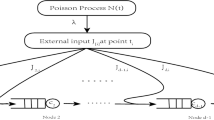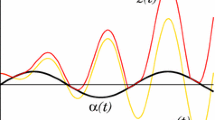Abstract
Recent Bellcore studies have shown that high-speed data traffic exhibits “long-range dependence”, characterized byH>0.5, whereH is the Hurst parameter of the traffic. In the wake of those studies, there has been much interest in developing tractable analytical models for traffic with long-range dependence, for use in performance evaluation and traffic engineering. Norros has used a traffic model known as Fractional Brownian Motion (FBM) to derive several analytical results on the behavior of a queue subject to such an arrival process. In this paper, we derive a new class of results, also based on the FBM model, which reveal rather curious and unexpected “crossover” properties of the Hurst parameter of the traffic, as regards its effect on the behavior of queues. These results, together with those of Norros, serve to enhance our understanding of the significance of the Hurst parameterH for traffic engineering. In particular, Krishnan and Meempat have used the crossover property derived here to explain, in part, a gap that existed between the results of two sets of Bellcore studies, one casting doubt on the usefulness of Markovian traffic models and methods whenH>0.5, and the other furnishing an example of successful traffic engineering with Markovian methods for traffic known to haveH>0.5. The results derived here can be used to obtainconservative estimates of the multiplexing gains achieved when independent traffic sources with the same Hurst parameterH are multiplexed for combined transmission. In turn, such estimates yield guidelines for the engineering of ATM links that are subject to traffic with long-range dependence.
Similar content being viewed by others
References
W. Willinger, M.S. Taqqu, W.E. Leland and D.V. Wilson, Self-similarity in high-speed packet traffic analysis and modeling of ethernet traffic measurements, Stat. Sci. 10 (1995) 67–85.
I. Norros, A storage model with self-similar input, Queueing Systems 16 (1994) 387–396.
I. Norros, On the use of fractional Brownian motion in the theory of connectionless networks, IEEE J. Select. Areas Commun. 13 (1995) 953–962.
A. Erramilli, O. Narayan and W. Willinger, Experimental queueing analysis with long-range dependent packet traffic, Bellcore Technical Report (1994).
D.P. Heyman, A. Tabatabai and T.V. Lakshman, Statistical analysis and simulation study of video teleconference traffic in ATM networks, IEEE Trans. Circuits and Syst. for Video Tech. 2 (1992) 49–59.
A. Elwalid, D.P. Heyman, T.V. Lakshman and D. Mitra, Fundamental bounds and approximations for ATM multiplexers with applications to video teleconferencing, IEEE J. Select. Areas Commun. 13 (1995) 1004–1016.
J. Beran, R. Sherman, M. Taqqu and W. Willinger, Long-range dependence in variable-bit-rate video traffic, IEEE Trans. Commun. 43 (1995) 1566–1579.
Bellcore Technical Report, to be published.
A. Erramilli, personal communication (1994).
K.R. Krishnan and G. Meempat, Long-range dependence in VBR video streams and ATM traffic engineering, Bellcore Technical Report (1995).
Author information
Authors and Affiliations
Rights and permissions
About this article
Cite this article
Krishnan, K.R. A new class of performance results for a fractional Brownian traffic model. Queueing Syst 22, 277–285 (1996). https://doi.org/10.1007/BF01149175
Received:
Revised:
Issue Date:
DOI: https://doi.org/10.1007/BF01149175




